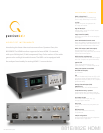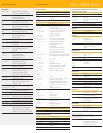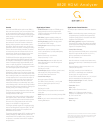
Quantum Data, Inc. 2111 Big Timber Road Elgin, IL 60123 USA Phone (847) 888-0450 Fax (847) 888-2802 www.quantumdata.com
ANALYZER OPTION
Overview
Use the DVI and HDMI analyzer option to test HDMI 1.3
deep color source products, such as set-top boxes, DVDs
as well as repeaters and cables. Source product manu-
facturers will find this option invaluable for verifying signal
quality, timing, color encoding, and E-EDID/E-DDC/HPD-
related behavior.
The analyzer option adds a digital video receiver to the
base instrument. This receiver emulates a sink device
(display), while the generator output emulates a source
(host) device. The receiver presents an on-the-fly repro-
grammable E-EDID to the source, and analyzes incoming
video for data errors and timing anomalies. The receiver
can analyze video from the instrument itself or from an
external source. Results can be displayed on the instru-
ment’s front panel or issued as formatted reports.
The HDMI and DVI analyzer option passes through the
incoming digital signal to the HDMI Tx interfaces, which can
be connected to a HDMI display for monitoring incoming
content. The displayed image rendered identically as the
source on a pixel per pixel basis. The analyzer also routes
incoming audio to a SPDIF output, which can be connected
to an external digital speaker or audio analyzer.
Signal quality can be measured without meticulous
inspection of a display screen. The analyzer accepts stan-
dard QDI-BCM pseudo-random noise test patterns, which
allow overall signal quality to be measured and expressed
in simple objective terms. In cases where the analyzer is
connected to a video source that does not support the
rendering of pseudo-random noise data, a pixel error
measurement technique can be alternately used, which
counts flickering pixels in still-frame test images. Detailed
pixel-by-pixel analysis is also supported for checking color
encoding, scaling, and masking in test images.
Timing can be measured, independent of video content.
The signal analyzer manager can be used to check sever-
al timings and obtain HTML report.
The analyzer option is also excellent for finding problems
with repeaters, cables, cable extenders, and distribution
systems. Everything needed to test transmission systems
from end-to-end, using pseudo-random noise or test
images, is now available in a single instrument.
The analyzer optionally supports CEC compliance testing
with the Test Management Environment (TME). The TME
application is used for testing CEC compliance in the
HDMI Authorized Test Centers.
The analyzer optionally supports HDCP compliance testing
enabling developers of HDMI products to perform fast,
comprehensive HDCP compliance test. on sources, sinks
or repeaters, in accordance with the HDCP compliance
test specification.
Signal Analyzer Features
> EEPROM Emulator emulates an EEPROM (up to 8
blocks) with rapid on-the-fly re-programmable
E-EDID for testing how source devices respond
to different sink devices.
> EDID Editor. Supports acquisition, editing and
emulation of EDIDs including CEA extension block.
> Hot-Plug Generator generates hot-plug events
in concert with E-EDID changes.
> Timing Analyzer measures timing of external
video signal.
Measurements: pixel rate, fields-per-frame,
H and V rate/total/active, sync delay/width/polarity/
H-to-V alignment
Machine Unit Accuracy: zero tolerance
Frequency Accuracy: < 0.3%
> Pixel Data Analyzer measures pixel values and
detects flickering pixels in user-defined region of
1024 square pixels.
Error Tallies: pixel errors (in static images)
Tally Range: 0 to 4095
> Packet Analyzer displays InfoFrame, general control,
audio sample, ACR, and generic data along
with audio channel status and errors.
> Pseudo-Noise Analyzer:
Noise type accepted: QDI-BCM
Error Tallies: Errors by channel (0, 1, and 2), total
pixel errors, floating-point pixel error rate (in
errors per-billion)
Tally Range: 0 to 4095
PN Error Memory: One expected and one measured
24-bit value
> HDMI TX ports are used for monitoring incoming HDMI
signal.
> SPDIF out port is used to extract audio embedded in
incoming HDMI stream.
Signal Generator Feature Extensions
The analyzer option enables these transmitter related fea-
tures:
> HDCP for functionally testing content protection proto-
col (production key is provided). Also supports HDCP
Compliance Testing (option) in accordance with HDCP
Compliance Test Specification.
> CEC Testing (optional). Integrated Troubleshooting
Environment (ITE) supports debug testing during devel-
opment and the Test management Environment (TME)
supports CEC Compliance Testing.
> Pseudo-Noise Generator:
Noise Type Generated: QDI-BCM (source code provided)
Sequence Length: manually set from 4 to (2^31-1)
pixels or automatically set to hActive*vActive
Bit-to-Bit Correlation: none
Noise Value Advance: manually choose between every
pixel and active pixels only or automatically set to active
pixels only
Sequence Repeat: continuous or stop after n=1 to
4,294,967,295 sequences
Seed Value: manually set form 0x00000001 to
0x7FFFFFFF or automatically set to 0x08000001
Re-seed Logic: via “magic” pixel value
Re-seed Period: manually set from 3 to 2,147,483,647
pixels or automatically set to hActive*vActive
> Analyzer-related Images: FormatRx, PacketRx,
ErrorRx HDMI Hardware
> Transmitter: Sil9134
Links: Single
CEC: Consumer Electronics Control
Audio: 8-Ch L-PCM programmable sinewave
(frequency and amplitude) at 32, 44.1, 48 88.2,
96, 176.4 and 192 kHz
> Receiver: Sil9135
Links: Single
Specifications are based on hardware and firmware revisions available as
of May 2008, and are subject to change without notice. HDMI, the HDMI
logo and High-Definition Multimedia interface are trademarks or regis-
tered trademarks of HDMI Licensing LLC.
Revised 05/29/08
882E HDMI Analyzer





